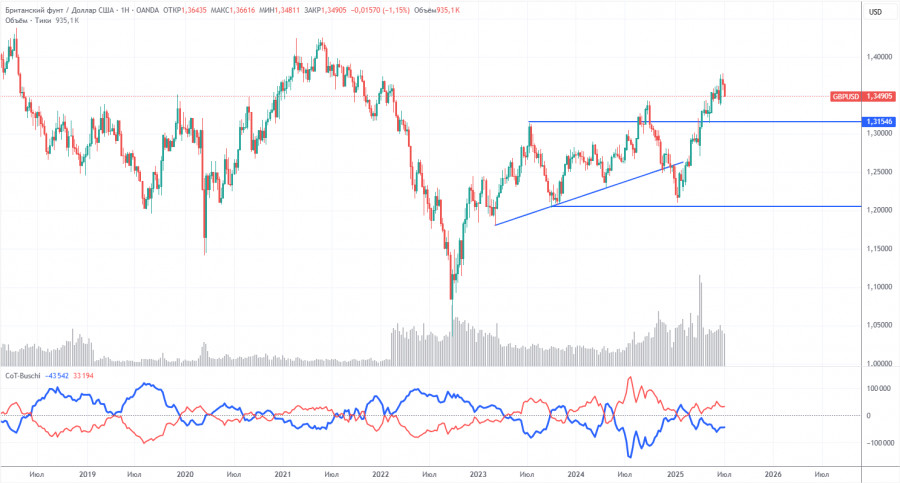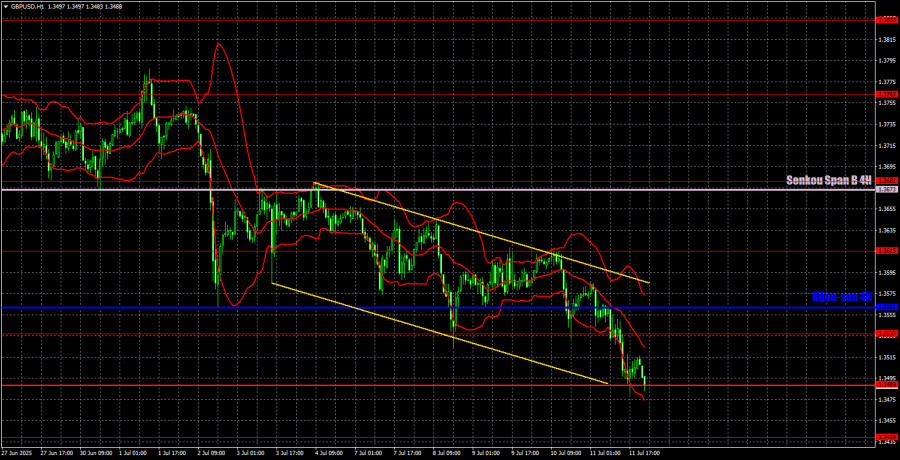
Scheduled Maintenance
Scheduled maintenance will be performed on the server in the near future.
We apologize in advance if the site becomes temporarily unavailable.
The GBP/USD currency pair continued its downward movement throughout Friday. We cannot say there were strong reasons for this, but in the morning, the UK released reports on GDP (monthly version) and industrial production. These reports showed relatively weak figures. For example, GDP contracted by 0.1% in May, while the forecast was +0.1%. Industrial production fell by 0.9% against a forecast of 0%. Thus, formally, the decline in the British pound was completely justified. However, we want to draw traders' attention to the fact that the pound has been falling all week, even though the fundamental background did not support the U.S. dollar. Therefore, we continue to believe that a technical corrective move is still underway.
On the hourly timeframe, the technical picture is currently very clear. The pair is strictly following a descending channel and is currently near its lower boundary and the 1.3489 level. Therefore, the price could begin recovering toward the Kijun-sen critical line as early as Monday. A confirmation of the end of the local downward trend would be a breakout above the channel.
On the 5-minute timeframe, several signals formed around the 1.3537 level on Friday, but they were not of high quality. The price generated two false buy signals before forming a valid sell signal, after which the nearest target—1.3489—was reached. A rebound from the 1.3489 level could also have been traded, but it did not lead to a strong upward movement. Most likely, the trade closed at breakeven via Stop Loss.

COT reports for the British pound show that in recent years, commercial traders' sentiment has changed constantly. The red and blue lines, representing the net positions of commercial and non-commercial traders, frequently cross and usually stay close to the zero line. Currently, they are also close to each other, indicating a roughly equal number of buy and sell positions. However, over the past 18 months, the net position has been growing and in recent months has been "bullish."
The dollar continues to decline due to Donald Trump's policies, so for now, the demand from market makers for the British pound is not particularly important. The trade war will continue in some form for a long time. Demand for the dollar will decline in one way or another. According to the latest report on the British pound, the "Non-commercial" group opened 800 BUY contracts and closed 900 SELL contracts. Thus, the net position of non-commercial traders increased by 1,700 contracts over the reporting week, which is practically insignificant.
The pound rose significantly in 2025, but it should be understood that the reason was Trump's policies. Once that factor is neutralized, the dollar could start to strengthen—but no one knows when that will happen. The dollar is only at the beginning of a challenging period. There are still 3.5 years left of Trump's administration.

On the hourly timeframe, the GBP/USD pair continues to move downward, as indicated by the descending channel. The market ignored Trump's new tariffs last week, which is quite illogical. This behavior by traders can, of course, be explained, but we believe that the new tariffs will be priced in once the current correction is over. Therefore, for now, trading to the downside on technical grounds is acceptable, but it should be kept in mind that the dollar still lacks strong reasons to rise.
For July 14, we highlight the following important levels: 1.3212, 1.3288, 1.3358, 1.3439, 1.3489, 1.3537, 1.3615, 1.3741–1.3763, 1.3833, 1.3886. The Senkou Span B line (1.3673) and Kijun-sen line (1.3562) can also serve as sources of signals. The Stop Loss level is recommended to be set to breakeven once the price moves 20 points in the correct direction. The Ichimoku indicator lines can shift during the day, which should be considered when identifying trading signals.
There are no important events scheduled for Monday in either the UK or the U.S., but during this week, Trump may continue to raise tariffs and introduce new ones. Last week, Trump raised tariffs for only a third of the countries on his "blacklist." An increase in tariffs for the second third can be expected.

Scheduled maintenance will be performed on the server in the near future.
We apologize in advance if the site becomes temporarily unavailable.